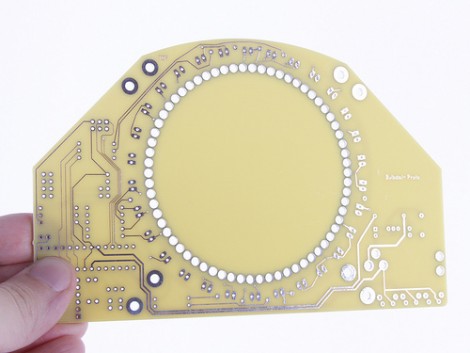
clock hacks984 Articles
Wristwatch Board With Throwback Digits
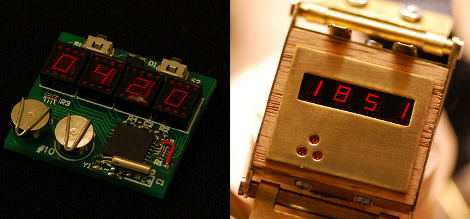
This wristwatch circuit board has some pretty interesting digits. They’re older components that give a classic look to your wristwatch display. On board you’ll find a PIC 16F628A running with an external clock crystal. The display isn’t always illuminated (kind of like Woz’s watch) in order to save the batteries, but can be woken up for a short time with the push of a button. The steam-punk-ish body seen to the left is the just first try. This guy has four more boards left so it should be fun to see what he comes up with.
[Via Hackaday Flickr Pool]
Making The Bulbdial Clock Touch Sensitive
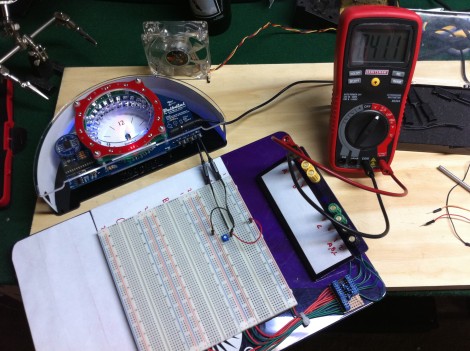
We never thought about it before, but having the controls on the bottom of a clock is a bit of an inconvenience. [Alex Whittemore] mutes the LEDs on his clock each night and after a while, decided he should make the mute button into a touch strip on the case. You’ll remember that the Bulbdial clock uses colored LEDs to create the effect of a sun-dial, casting colored shadows for each hand of the clock. It makes sense that this would put off a pretty good amount of light at night. [Alex’s] original thought was to use a capacitive touch sensor but complexity and cost were in his way. What he ended up with is a resistive touch switch based off of two metal strips. He used metal repair tape but suggests copper foil as he was unable to solder to tape. When your finger touches the two strips it completes the circuit for the base of a transistor, which in turn grounds the mute button on the clock. Cheap, simple, and illustrated in the video after the break.
Continue reading “Making The Bulbdial Clock Touch Sensitive”
MSP430 Based Single LED Clock
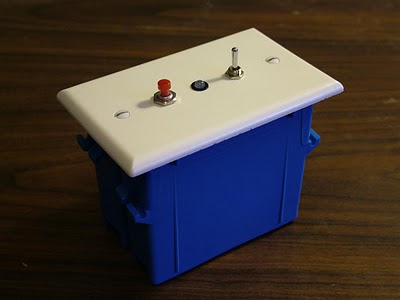
[Kenneth Finnegan’s] latest clock makes use of the TI Launchpad for programming and debugging MSP430 microprocessors. We took a look at the Launchpad when it was released and we’re glad to see some hacks resulting from availability of that tool. The clock reads out the time using a bi-color LED. Press the button and a series of flashes will tell you the time. A three-position toggle switch is used along with the push button for setting the time. The protocol he developed is outlined in his demo video after the break.
We like [Kenneth’s] use of a plastic electrical box as a project box. They’re cheap and you can find them everywhere in many different sizes. He mentions the difficulty in drilling through the faceplate. We’ve had our share of shattered plastic trying to drill holes in the darn things. If you’ve got some tips on faceplate-modification we’d love to hear them.
This clock is sure the polar opposite from the TTL clock that [Kenneth] showed us back in March, trading jumper wires for lines of code. We’re going to give this one a try, hopefully fixing the button debounce along the way.
Ice Tube Clock GPS
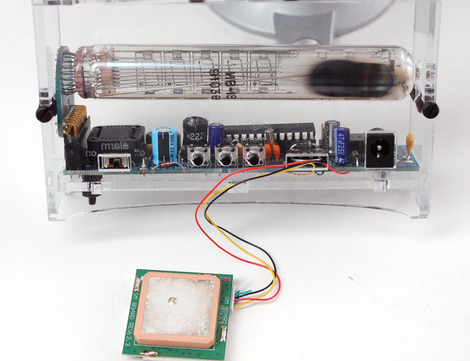
Our favorite Soviet-Era display that found its way into a present-day kit now displays time from orbiting satellites. A GPS module patched into an Ice Tube Clock with modified firmware will be able to provide a satellite-synced time. The firmware, modified by yours truly, parses the GPS module’s NMEA RMC sentences for the time and date information and then updates the clock’s time and date. Fun was had making sure the alarm went off at the correct times when the time was updated by the GPS. Overall, it was a fun project and we look forward to seeing additional Ice Tube Clock hacks.
Lolo’s (perfect Moment) Alarm Clock
[youtube http://www.youtube.com/watch?v=CphsgESZGcE&feature=player_embedded%5D
It seems everybody has a different interpretation of the perfect alarm clock. [Loic Royer’s] alarm clock is not the loudest, or the smartest, but does have some interesting features. By monitoring several environmental factors like temperature, air quality, humidity, dew point, and your own sleep patterns, this alarm clock can determine the best moment in the morning to wake you up.
The main sensor is a wireless accelerometer with the theory being: the more you move in your sleep, the closer you are to a conscious state. The other sensors assist in picking the perfect moment, and awaken you with the sound of birds chirping.
For now all we have is the source code and the list of hardware, but for anyone wanting to try, a circuit diagram wouldn’t be too hard to figure out on your own. Check after the rift for some more videos. Continue reading “Lolo’s (perfect Moment) Alarm Clock”
Neon Binary Clock

[Josiah] said ‘no’ to LEDs and instead used blue-phosphor neon lamps to build this binary clock. The ATmega328 inside uses three 8-bit shift registers to control the display. Each lamp needs a high-voltage NPN transistor in order to switch on the 150V necessary for proper illumination. A simple circuit was used to pull a 60 Hz clock signal out of the incoming 16VAC power. Unfortunately it was a bit too simple and didn’t provide a clean signal. [Josiah’s] workaround is something of a debounce subroutine in the firmware to prevent multiple interrupts on the falling edge.
The last project we saw from [Josiah] was the Coachella Lamp. That was a show piece of antiquated technology and this is another show piece with a minimalistic style. We also liked seeing the protoboard work on the inside. That’s a pretty jam-packed circuit board and keeping everything in the right place while you build up each trace with blobs of solder is no small feat.










